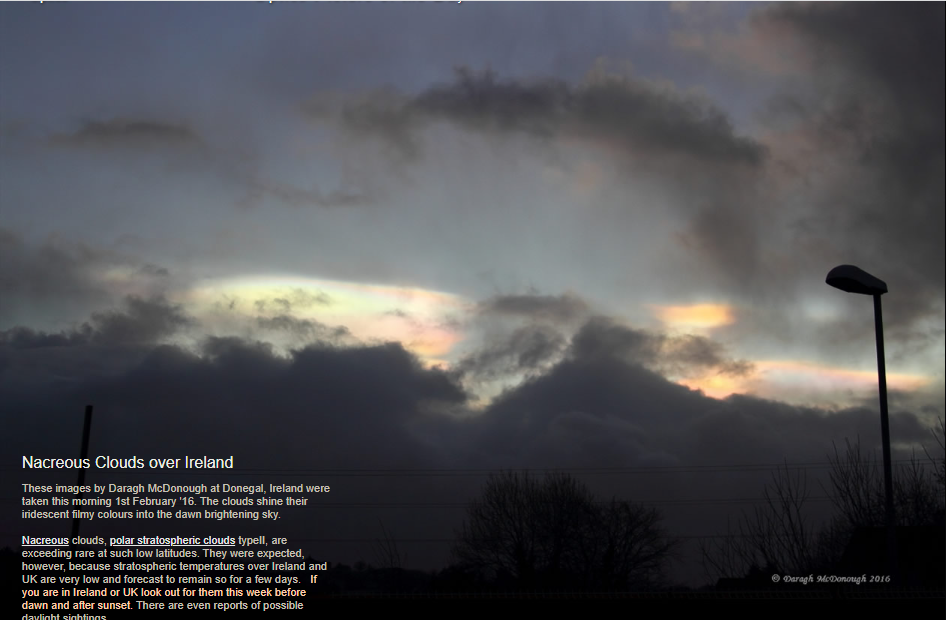Nacreous, polar stratospheric clouds, Donegal, Ireland - OPOD
Nacreous Clouds: A Rare Atmospheric Phenomenon in Donegal, Ireland
Nacreous clouds, also known as polar stratospheric clouds type II, are a mesmerizing and extremely rare sight in the skies. These iridescent clouds create a stunning display of filmy colors during the early morning and late evening hours. Although they are typically found at high latitudes such as Scandinavia and Iceland, they occasionally venture further south, surprising observers in places like Donegal, Ireland.
The Rarity of Nacreous Clouds
Nacreous clouds are arguably the rarest clouds on the planet. Their occurrence is limited to specific atmospheric conditions and geographical locations. While they are commonly seen in regions closer to the poles, their appearance in areas with lower latitudes, like Donegal, Ireland, is quite exceptional.
Composition and Formation
Unlike other polar stratospheric clouds (PSCs), nacreous clouds consist of benign ice crystals rather than nitrogen acids that can contribute to the depletion of protective ozone. These unique ice crystals form at an altitude of 15 to 25 kilometers in the lower stratosphere.
Nacreous clouds require specific temperature conditions to form, typically around -85 degrees Celsius or lower. Interestingly, these atmospheric wonders often coincide with strong gusting surface winds, which may aid in transporting the necessary water into the stratosphere. This combination of low temperatures and favorable wind patterns contributes to the formation of these ethereal clouds.
Observing Nacreous Clouds
If you find yourself in Ireland or the UK, keep an eye out for nacreous clouds during the week before dawn and after sunset. These elusive clouds have even been reported to appear during daylight hours, adding to their mystique.
To increase your chances of spotting nacreous clouds, head to an open area with an unobstructed view of the sky. Look towards the horizon where the sun is either rising or setting, as this is where the clouds are most likely to be visible. Remember to be patient, as these rare phenomena may require some luck and perseverance to witness.
Captivating Visual Display
When nacreous clouds grace the sky, they create a captivating visual spectacle. Their iridescent colors shimmer and change as the sunlight interacts with the ice crystals suspended in the atmosphere. Shades of pink, purple, blue, and orange blend together, forming a breathtaking display that is truly a feast for the eyes.
Appreciating Nature's Wonders
Witnessing nacreous clouds is a reminder of the immense beauty and complexity of our natural world. These rare atmospheric phenomena serve as a humbling reminder of the intricate interplay between temperature, wind patterns, and the composition of our atmosphere.
As we marvel at the stunning colors and delicate formations of nacreous clouds, we are reminded of the importance of preserving and protecting our environment. These clouds are a reminder of the fragility of our ozone layer and the need to continue efforts in reducing harmful emissions and promoting sustainable practices.
Conclusion
Nacreous clouds are a true rarity, gracing the skies with their enchanting presence. While typically found in high-latitude regions, their occasional appearance in lower latitudes like Donegal, Ireland, is a remarkable event. If you have the opportunity to witness these ethereal clouds, take a moment to appreciate the beauty and wonder of our natural world. Let us continue to protect and cherish our environment, ensuring that future generations can also witness the awe-inspiring display of nacreous clouds in the years to come.

Nacreous Clouds over Ireland
These images by Daragh McDonough at Donegal, Ireland were taken this morning 1st February '16. The clouds shine their iridescent filmy colours into the dawn brightening sky.
Nacreous clouds, polar stratospheric clouds typeII, are exceeding rare at such low latitudes. They were expected, however, because stratospheric temperatures over Ireland and UK are very low and forecast to remain so for a few days. If you are in Ireland or UK look out for them this week before dawn and after sunset. There are even reports of possible daylight sightings.
Images ©Daragh McDonough, shown with permission

Nacreous clouds are arguable the planet's rarest.
They occur mostly at high latitudes, Scandinavia and Iceland but once every few years make forays further south.
They are 15 - 25 km high in the lower stratosphere. Compared with other PSCs (polar stratospheric clouds) they are composed of benign ice crystals. Other PSCs have nitrogen acids that catalyse the destruction of protective ozone.
Nacreous clouds form at temperatures of -85 Celsius and below and (like now!) are often associated with very strong gusting surface winds that possibly help transport the necessary water into the stratosphere.
Note: this article has been automatically converted from the old site and may not appear as intended. You can find the original article here.
Reference Atmospheric Optics
If you use any of the definitions, information, or data presented on Atmospheric Optics, please copy the link or reference below to properly credit us as the reference source. Thank you!
-
<a href="https://atoptics.co.uk/blog/nacreous-polar-stratospheric-clouds-donegal-ireland-opod/">Nacreous, polar stratospheric clouds, Donegal, Ireland - OPOD</a>
-
"Nacreous, polar stratospheric clouds, Donegal, Ireland - OPOD". Atmospheric Optics. Accessed on November 26, 2024. https://atoptics.co.uk/blog/nacreous-polar-stratospheric-clouds-donegal-ireland-opod/.
-
"Nacreous, polar stratospheric clouds, Donegal, Ireland - OPOD". Atmospheric Optics, https://atoptics.co.uk/blog/nacreous-polar-stratospheric-clouds-donegal-ireland-opod/. Accessed 26 November, 2024
-
Nacreous, polar stratospheric clouds, Donegal, Ireland - OPOD. Atmospheric Optics. Retrieved from https://atoptics.co.uk/blog/nacreous-polar-stratospheric-clouds-donegal-ireland-opod/.